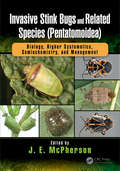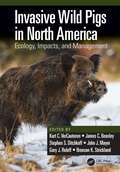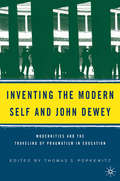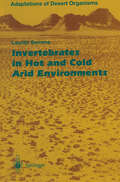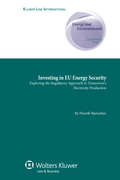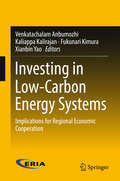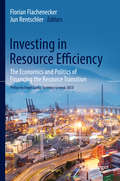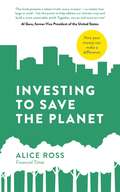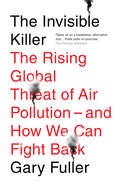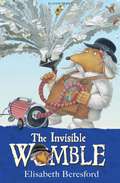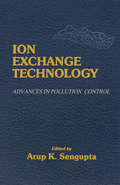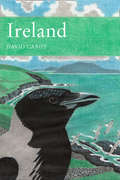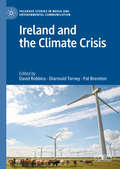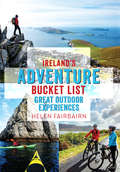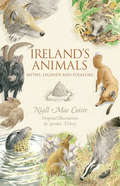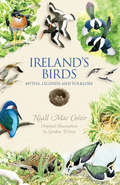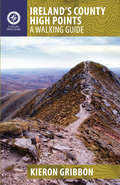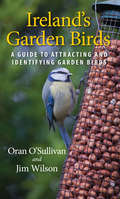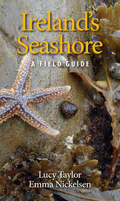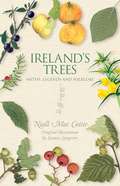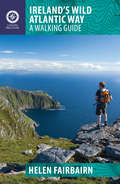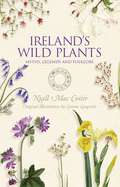- Table View
- List View
Invasive Stink Bugs and Related Species: Biology, Higher Systematics, Semiochemistry, and Management (Contemporary Topics in Entomology)
by J. E. McPhersonKey features: Presents a brief history of past classifications, a summary of present classification, and speculation on how the classification may evolve in the future Includes keys for the identification of families and subfamilies of the Pentatomoidea and for the tribes in the Pentatomidae Explains transmission of plant pathogens and concepts of pathology and heteropteran feeding for the non-specialist Provides an extensive literature review of transmission by stink bugs of viral, bacterial, fungal, and protozoan organisms that cause diseases of plants Discusses the diversity of microbial symbionts in the Pentatomidae and related species, showing how microorganisms underpin the evolution of this insect group Reviews semiochemicals (pheromones, kairomones, allomones) of the Pentatomoidea and their vital role in the life histories of pest and beneficial species and their exploitation by natural enemies of true bugs Covers past, current, and future control options for insects, with a focus on stink bugs and related heteropterans The Superfamily Pentatomoidea (stink bugs and their relatives) is comprised of 18 families with over 8,000 species, the largest of which is the family Pentatomidae (about 5,000 species). These species primarily are phytophagous, and many cause tremendous economic damage to crops worldwide. Within this superfamily are six invasive species, two that occur worldwide and four that are recent invaders in North America. Once established in new geographic regions, these species have increased their numbers and geographic distributions dramatically, causing economic damage totaling billions of dollars. Invasive Stink Bugs and Related Species (Pentatomoidea): Biology, Higher Systematics, Semiochemistry, and Management is the first book that presents comprehensive coverage of the biology of invasive pentatomoids and related true bug species and addresses issues of rapidly growing economic and environmental concerns. Containing the contributions of more than 60 stink bug specialists from 15 countries, this book provides a better understanding of the biology and economic importance of these invasive species, why they became invasive, and how their continued geographical expansion is likely to affect numerous agricultural systems and natural environments. Including over 3,500 references, this authoritative work serves as an access point to the primary literature on their life histories, higher systematics, diapause and seasonal cycles, pathogens, symbionts, semiochemistry, and pest management control strategies for pentatomoid bugs.
Invasive Stink Bugs and Related Species: Biology, Higher Systematics, Semiochemistry, and Management (Contemporary Topics in Entomology)
by J. E. McPhersonKey features: Presents a brief history of past classifications, a summary of present classification, and speculation on how the classification may evolve in the future Includes keys for the identification of families and subfamilies of the Pentatomoidea and for the tribes in the Pentatomidae Explains transmission of plant pathogens and concepts of pathology and heteropteran feeding for the non-specialist Provides an extensive literature review of transmission by stink bugs of viral, bacterial, fungal, and protozoan organisms that cause diseases of plants Discusses the diversity of microbial symbionts in the Pentatomidae and related species, showing how microorganisms underpin the evolution of this insect group Reviews semiochemicals (pheromones, kairomones, allomones) of the Pentatomoidea and their vital role in the life histories of pest and beneficial species and their exploitation by natural enemies of true bugs Covers past, current, and future control options for insects, with a focus on stink bugs and related heteropterans The Superfamily Pentatomoidea (stink bugs and their relatives) is comprised of 18 families with over 8,000 species, the largest of which is the family Pentatomidae (about 5,000 species). These species primarily are phytophagous, and many cause tremendous economic damage to crops worldwide. Within this superfamily are six invasive species, two that occur worldwide and four that are recent invaders in North America. Once established in new geographic regions, these species have increased their numbers and geographic distributions dramatically, causing economic damage totaling billions of dollars. Invasive Stink Bugs and Related Species (Pentatomoidea): Biology, Higher Systematics, Semiochemistry, and Management is the first book that presents comprehensive coverage of the biology of invasive pentatomoids and related true bug species and addresses issues of rapidly growing economic and environmental concerns. Containing the contributions of more than 60 stink bug specialists from 15 countries, this book provides a better understanding of the biology and economic importance of these invasive species, why they became invasive, and how their continued geographical expansion is likely to affect numerous agricultural systems and natural environments. Including over 3,500 references, this authoritative work serves as an access point to the primary literature on their life histories, higher systematics, diapause and seasonal cycles, pathogens, symbionts, semiochemistry, and pest management control strategies for pentatomoid bugs.
Invasive Wild Pigs in North America: Ecology, Impacts, and Management
by Kurt VerCauteren James Beasley Stephen S. Ditchkoff John J. Mayer Gary J. Roloff Bronson K. StricklandThroughout North America, non-native wild pigs have become an ecologically and economically destructive invasive species. Though they are regarded as a popular game species by some, provide economic benefits to others, and are even engrained into societal heritage in some areas, wild pigs are responsible for an extraordinary amount of damage in both natural and anthropogenic systems throughout North America. As the density and range of wild pig habitat have substantially increased over the last several decades, the magnitude and diversity of their negative impacts are not yet fully realized or quantified. With various conflicts continually emerging, wild pig management is difficult and expensive to achieve. As a result, wild pigs represent one of the greatest wildlife management challenges North America faces in the 21st century. Invasive Wild Pigs in North America: Ecology, Impacts, and Management addresses all aspects of wild pig biology, ecology, damage, and management in a single comprehensive volume. It assimilates and organizes information on the most destructive introduced vertebrate species in the United States, establishing a foundation from which managers, researchers, policy makers, and other stakeholders can build upon into the future. The book provides comprehensive coverage of wild pig biology and ecology, techniques for management and research, and regional chapters. It is an asset to readers interested in wild pigs, the resources they impact, and how to mitigate those impacts, and establishes a vision of the future of wild pigs in North America. Features: Compiles valuable knowledge for a broad audience including wild pig managers, researchers, adversaries, and enthusiasts from across North America Addresses taxonomy, morphology, genetics, physiology, spatial ecology, population dynamics, diseases and parasites, and the naturalized niche of wild pigs Includes chapters on damage to resources, management, research methods, human dimensions and education, and policy and legislation Contains full color images and case studies of interesting and informative situations being created by wild pigs throughout North America Includes a chapter on wild pigs at the wildland–urban interface, a more recent and especially challenging issue
Invasive Wild Pigs in North America: Ecology, Impacts, and Management
by Kurt C. VerCauteren James C. Beasley Stephen S. Ditchkoff John J. Mayer Gary J. Roloff Bronson K. StricklandThroughout North America, non-native wild pigs have become an ecologically and economically destructive invasive species. Though they are regarded as a popular game species by some, provide economic benefits to others, and are even engrained into societal heritage in some areas, wild pigs are responsible for an extraordinary amount of damage in both natural and anthropogenic systems throughout North America. As the density and range of wild pig habitat have substantially increased over the last several decades, the magnitude and diversity of their negative impacts are not yet fully realized or quantified. With various conflicts continually emerging, wild pig management is difficult and expensive to achieve. As a result, wild pigs represent one of the greatest wildlife management challenges North America faces in the 21st century. Invasive Wild Pigs in North America: Ecology, Impacts, and Management addresses all aspects of wild pig biology, ecology, damage, and management in a single comprehensive volume. It assimilates and organizes information on the most destructive introduced vertebrate species in the United States, establishing a foundation from which managers, researchers, policy makers, and other stakeholders can build upon into the future. The book provides comprehensive coverage of wild pig biology and ecology, techniques for management and research, and regional chapters. It is an asset to readers interested in wild pigs, the resources they impact, and how to mitigate those impacts, and establishes a vision of the future of wild pigs in North America. Features: Compiles valuable knowledge for a broad audience including wild pig managers, researchers, adversaries, and enthusiasts from across North America Addresses taxonomy, morphology, genetics, physiology, spatial ecology, population dynamics, diseases and parasites, and the naturalized niche of wild pigs Includes chapters on damage to resources, management, research methods, human dimensions and education, and policy and legislation Contains full color images and case studies of interesting and informative situations being created by wild pigs throughout North America Includes a chapter on wild pigs at the wildland–urban interface, a more recent and especially challenging issue
Inventing the Modern Self and John Dewey: Modernities and the Traveling of Pragmatism in Education
by T. PopkewitzThis collection includes original studies from scholars from thirteen nations, who explore the epistemic features figured in John Dewey's writings in his discourses on public schooling. Pragmatism was one of the weapons used in the struggles about the development of the child who becomes the future citizen. The significance of Dewey in the book is not about Dewey as the messenger of pragmatism, but in locating different cultural, political and educational terrains in which debates about modernity, the modern self and the making of the citizen occurred.
Invertebrates in Hot and Cold Arid Environments (Adaptations of Desert Organisms)
by Lauritz SommeA comparison of the adaptations made by invertebrates in polar deserts with those of temperate and subtropical deserts. These regions represent some of the most hostile environments on earth, demanding an array of strategies for survival. Polar species are well adapted to the cold and have to cope with arid conditions due to low precipitation and lack of liquid water during the winter. Similarly, temperate desert invertebrates have adapted to dry conditions and are also exposed to low winter temperatures. Terrestrial arthropods maintain their water-balance through behavioural and physiological adaptations. Tardigrades and nematodes are remarkable in their ability to shed all their water before entering a state of anhydrobiosis only to be revived when moisture once again becomes available.
Investing in EU Energy Security: Exploring the Regulatory Approach to Tomorrow’s Electricity Production
by Henrik BjørnebyeThe author of this timely and sharply focused book shows that, in the light of our current knowledge, ensuring new investments – and the right investments – in electricity generation constitutes an urgent energy policy challenge facing the EU over the coming decades. He accordingly makes the case for a serious reconsideration of the market facilitation and market intervention rules under electricity market legislation in the EU. In the first detailed legal analysis of the EU’s internal electricity market framework for investments in electricity generation facilities from the perspective of security of supply, this book cover such legal issues as the following in precise detail: applicability of the Treaty on the Functioning of the European Union (TFEU); security of supply as a ground for exemption on the basis of public security; justifications of public intervention; the applicability of EU State aid provisions to investments in energy security; requirements imposed by EU law on Member States for ensuring cost-efficient investments in European supply security; facilitation of renewable energy sources and cogeneration in the environmental interest; the Court of Justice’s approach to Member State interventions; the Court’s decisions on restrictions on free movement in the environmental interest; Member States’ right to launch tendering procedures for new generation capacity; Member States’ right to impose public service obligations in the general economic interest on certain undertakings; and relationship between the provisions of the TFEU and those of the Euratom Treaty in relation to investments in nuclear power generation. Throughout the study, in addition to his analysis of the decisions of the Court of Justice and the Court of First Instance, the author takes into account legal literature and Union reports, preparatory works, and working papers. The book demonstrates convincingly that today’s energy supply challenges must be based on a broader balancing of security, competitiveness and sustainability interests. It suggests that the internal electricity market provisions of the Electricity Directive and the Security of Electricity Supply Directive would benefit from focusing more intensely on requiring investments in technologies and primary energy sources that will help mitigate climate change and reduce European energy import dependency, and less on the need for ensuring cost-efficient investments through market-based means
Investing in Low-Carbon Energy Systems: Implications for Regional Economic Cooperation
by Venkatachalam Anbumozhi Kaliappa Kalirajan Fukunari Kimura Xianbin YaoThis book focuses on multi-level actions that have attracted considerable interest and discussion within academia, decision makers and the public as a tool to assess anthropogenic effects of low-carbon energy development. The book begins with an overview of the state of the art policies in emerging economies, which provides a starting point for understanding the concept of low-carbon green growth. A unified framework for structuring, categorizing, and integrating various regional-level actions is established on the basis of a thorough investigation into the theoretical and methodological aspects of non-conventional energy policies that have been widely adopted. Furthermore, the book brings clarity to the relationship between clean energy policies and stakeholder participation, and the significance of coordinated actions at the regional level. The findings provide novel insights and policy tools to help decision-makers in identifying ways to mobilize private investment in low-carbon energy systems.
Investing in Resource Efficiency: The Economics and Politics of Financing the Resource Transition
by Florian Flachenecker Jun RentschlerThis book covers the multi-faceted incentives, trade-offs, and challenges associated with the economics and politics of resource efficiency investments. By contributing a wide range of empirical evidence, practitioners' insights, and policy perspectives, this book carefully examines the role of resource efficiency in reconciling environmental and economic considerations. It also discusses the critical role of resource efficiency investments in mitigating climate change and enabling sustainable development. Featuring expert insights from academia, the European Commission, the European Investment Bank, and the European Bank for Reconstruction and Development, this book provides a policy oriented guide, reference, and toolbox for unlocking the potential of resource efficiency. To this end, it identifies practical measures for overcoming barriers and creating smart incentives for leveraging resource efficiency investments. Overall, this book brings together evidence to develop innovative ideas and strategies for improving the efficient use of resources and advancing clean and sustainable development."This book is an important and timely contribution", Angel Gurria, Secretary General, OECD
Investing To Save The Planet: How Your Money Can Make a Difference
by Alice Ross'This book presents a salient truth: every investor - no matter how large or small - has the power to help address our climate crisis and build a more sustainable world. Together, we can and must act now' Al Gore, former Vice President of the United States 'Everyone's savings account and pension can meaningfully contribute. Ross tells us how in this clear, easy to understand yet transformative book' Christiana Figueres, Founding Partner, Global Optimism and Former Executive Secretary, United Nations Framework Convention on Climate Change 'I can't imagine a more important book at the moment. A detailed, action-oriented guide on how to make our money matter and save us and the planet we live on' Richard Curtis, Writer, Director, Co-Founder of Red Nose Day and UN Sustainable Development Goals Advocate Investing responsibly is one of the most powerful ways that you can fight climate change. No longer a niche sector for rebel fund managers, conscious investing has the potential to raise huge sums of money to the companies and organisations on the front line fighting the climate crisis and make investors positive returns in the process. In this essential introduction to green investing, Alice Ross shows you how you can turn your savings and pensions, however big or small, into a force for change. You will learn: - Which sectors are leading the charge by developing cutting-edge solutions; from smart farming to renewable energy- How to cut through 'alphabet soup' jargon and identify 'greenwashing' - The ways you can maximise your economic power and hold those you're investing in to account 'Changing the way that we invest is one of the most powerful levers we have for solving climate change. This hugely interesting and immensely practical book not only explains why changing how we invest is so critically important but also provides a set of powerful tools for actually doing it' Rebecca Henderson, John and Natty McArthur University Professor at Harvard University and author of Reimagining Capitalism 'Explains the power you have, through your investment choices, to accelerate the path toward a sustainable clean energy future. Read this book and be empowered to create a better future for the planet' Michael Mann, Distinguished Professor, Penn State University, author of The New Climate War
The Invisible Killer: The Rising Global Threat of Air Pollution - and How We Can Fight Back
by Gary FullerAn urgent examination of one of the biggest global crises facing us today, air pollution, looking at the rise of the problem, how we understand it and what needs to change.More than 90% of the world’s population is exposed to air pollutant concentrations exceeding World Health Organisation guideline levels. Having air that is healthy to breathe is one of the greatest challenges of the 21st Century. Some of this is unfinished business from the last 60 years, but as more and more of us live in cities, more of us are living close to pollution sources. Europe is wrestling with air pollution from diesel transport and in China and India they are facing air pollution problems that they have never met before.The air pollution that we breathe every day is largely invisible to us but it is having a significant impact on our health and that of our children. The Invisible Killer will take you on a journey from London to Los Angeles to Beijing, challenging our ideas of what creates air pollution and how we measure it, and introducing us to incredible individuals whose groundbreaking research paved the way to today’s understanding, often at their own detriment.Dr Fuller argues that to change the future of our planet and collective global health, city and national government action is essential. It is not for lack of evidence that air pollution harm persists. Instead it remains in place due to a lack of political will to make changes to our urban lives, to persuade the public and to make polluters bear the full cost of the harm that they do.
The Invisible Womble (Young Childrens Fiction Ser.)
by Elisabeth Beresford Nick PriceOrinoco is certainly the tubbiest of the Wombles and is perhaps the Womble who needs the most encouragement to go out on the daily sortie to clear up and recycle all the rubbish that humans leave behind . . . Meanwhile, Tomsk, DIY-er extraordinaire, is getting to grips with the one of the humans' more ingenious inventions: the vacuum cleaner!
Ion Exchange Technology: Advances in Pollution Control
by Arup K. SenGuptaThis book provides comprehensive coverage of developments in ion exchange areas which would continue to have major impacts in the general pursuit of pollution control and pollution prevention. Its nine chapters can be split into four different theme areas: trace contaminants removals; new materials; desalination and finally controlling gaseous pollutants. This would have value for practicing engineers, scientists and researchers who are pertaining to ion exchange technology. It would also server the needs of those trying to explore and identify new technologies in the areas of pollution control and pollution prevention.
Ion Exchange Technology: Advances in Pollution Control
by Arup K. SenGuptaThis book provides comprehensive coverage of developments in ion exchange areas which would continue to have major impacts in the general pursuit of pollution control and pollution prevention. Its nine chapters can be split into four different theme areas: trace contaminants removals; new materials; desalination and finally controlling gaseous pollutants. This would have value for practicing engineers, scientists and researchers who are pertaining to ion exchange technology. It would also server the needs of those trying to explore and identify new technologies in the areas of pollution control and pollution prevention.
Ireland: A Natural History (Collins New Naturalist Library #84)
by David CabotAnother volume in the popular New Naturalist series, this book covers all aspects of the natural history of Ireland, from biological history, geology and climate, through to nature conservation.
Ireland and the Climate Crisis (Palgrave Studies in Media and Environmental Communication)
by David Robbins Diarmuid Torney Pat BreretonThis book provides a comprehensive overview of Ireland’s response to the climate crisis. The contributions, written by leading scholars across a range of disciplines in the social sciences, humanities and beyond, shed light on diverse aspects of the climate crisis, the factors shaping Ireland’s response, and prospects for the future. Long regarded as a ‘climate laggard’, Ireland’s response to the urgent societal challenge of climate change has seen new momentum in recent times. The volume will serve as a key reference point for academics, students, policymakers, and a wide range of stakeholders. It will be of interest to readers within Ireland, as well as further afield, who wish to gain a deeper understanding of the constraints on, and opportunities for, successful climate action in Ireland.
Ireland's Adventure Bucket List: Great Outdoor Experiences
by Helen FairbairnAdventure is closer than you think. Ireland’s wild scenery and dramatic landscapes call out for exploration, and this inspirational guide will open your eyes to the huge variety of exhilarating outdoor experiences the country has to offer. Whether you want to sea kayak around remote stacks and arches, discover delicate stalactites in underground caverns, stand amidst a colony of breeding seabirds or scramble up a rocky ridge to the country’s highest summit, this book shows you how. From snorkelling in County Cork to island-hopping in County Donegal, there are trips to suit all levels of expertise in every province of Ireland. With all the practical details you need to plan your outing – including comprehensive route descriptions, handy trip-summary boxes and maps – you can set off to explore the country’s most spectacular spots in confidence. Embark on an epic journey to tick off the whole bucket list, or cherry-pick your favourite activities for weekend adventures. Either way you’re guaranteed to be invigorated by the scale of Ireland’s natural wonders.
Ireland’s Animals: Myths, Legends And Folklore
by Niall Mac CoitirNiall Mac Coitir provides a comprehensive look at the folklore, legends and history of animals in Ireland, and describes their relations with people, being hunted for food, fur, sport, or as vermin, and their position today. A final section, inspired by stories of animal transformation, looks at twelve animals and how we can enrich our lives by visualising ourselves with their special qualities. This fascinating and beautifully illustrated compilation of folklore, legends and natural history will delight all with an interest in Ireland’s animals.
Ireland's Birds: Myths, Legends And Folklore
by Niall Mac CoitirBirds have been important symbols in our art and culture for thousands of years. They have inspired poets and painters, and feature in many place names and legends. In this book, Niall Mac Coitir draws together the mythology, legends and folklore of Ireland's birds, both wild and domestic. The birds are presented in seasonal order based on their migratory habits (the cuckoo and summer) or on their cultural associations (the robin with Christmas). He also explores how birds are often powerful symbols of various virtues and qualities, such as the goose, which is a symbol of watchfulness and bravery. This challenges us to look at birds in a different way, as dynamic creatures that have influenced our society over the millennia. Written with imagination and enthusiasm, this mix of natural history, mythology and folklore will delight and enlighten all interested in the birds of Ireland.
Ireland's County High Points: A Walking Guide (A Walking Guide)
by Kieron GribbonWhether a leisurely rambler or a serious hill walker, there’s a good chance you’ve visited or plan to visit at least one of Ireland’s County High Points. While this special set of Irish hills and mountains continues to attract more visitors each year, they’ve never had a walking guidebook exclusively devoted to them. Ireland’s County High Points – A Walking Guide explains everything you need to know as a walker before setting out on your County High Point quests. Each county-focused chapter contains a brief county profile and detailed walking route descriptions accompanied by easy-to-read maps. Also featured are various challenge options based on County High Points. This definitive guide is based on detailed desk-study investigation combined with on-site research, and dispels any commonly believed myths that may have previously lingered over certain County Top and County Peak locations. • Detailed route instructions and maps in practical format • Other Walking Guides also available: Carrauntohil & MacGillycuddy’s Reeks by Jim Ryan; The Burren and the Aran Islands by Tony Kirby; Northern Ireland by Helen Fairbairn. For a complete list of walking guides available from The Collins Press, see www.collinspress.ie
Ireland's Garden Birds: A Guide to Attracting and Identifying Garden Birds
by Oran O'Sullivan Jim WilsonAn essential companion for bird lovers and gardeners alike since it was first published, this highly successful guide to identifying garden birds has now been fully updated with the latest information and statistics. Highlighting a range of plants and planting schemes that support wildlife, it provides expert advice on making your garden a haven for birds. Learn everything you need to know about all the birds you’re most likely to see from your window, how to attract them into your garden and how to care for them. Each species is accessibly described, with details of identification, status and abundance, feeding habits, songs and call, and breeding season. The species guide has been updated to include the Great Spotted Woodpecker, which is now breeding regularly on the east coast and turning up in gardens. The species descriptions are enhanced by new photographs of the highest quality. Whether you are an avid gardener or just love feeding birds in your garden, this practical and easy-to-use guide is invaluable. Also available: 'Birds of Ireland – A Field Guide'
Ireland's Seashore: A Field Guide
by Lucy Taylor Emma NickelsenIreland’s seashores are famous for their spectacular beauty, ranging from exposed rocky headlands that receive the full power of the Atlantic to enclosed sea loughs and sheltered mudflats. Our northern latitude means that some Arctic species find a home here, but the warm currents that flow up from the Gulf of Mexico also make Irish shores habitable for species found in southern Europe, the Canaries and the Mediterranean. Providing habitats like no other, our coasts are teeming with plant and animal life. Whether you visit on a sunny summer day or for a wild walk in winter, there is always something interesting to see, either living on the shore or washed up from the sea. Beginning with clear background information on types of shore, tides, waves, coastal habitats and conservation, this highly accessible guide has everything you need to understand the wildlife on our coastline. A helpful identification guide uses simple questions (e.g. ‘Does it have a shell?’) to guide you to the correct section (e.g. ‘Snails, mussels and their relatives’), where you will find an introduction to the species, followed by detailed entries on the most common shoreline inhabitants: Irish and Latin names, size, distribution and memorable nuggets of information (did you know banded wedge shells can leap if disturbed?). Written by qualified marine biologists with a passion for their subject, this is the ideal companion on any seashore ramble, whether you are a beginner or an experienced naturalist.
Ireland's Trees – Myths, Legends & Folklore: Myths, Legends And Folklore
by Niall Mac CoitirName the five Great Trees of Ireland? What trees are most often found beside holy wells or cemeteries? Which tree gave the Red Branch Knights of Ulster their name? Ireland was once so heavily wooded it was said a squirrel could travel from Cork to Killarney without touching the ground. So it is no surprise that, in ancient Ireland, mythology and folklore were a part of the people's general knowledge about trees. Many of the myths and legends and much of the folklore associated with native trees persists to this day and are gathered together in this book.
Ireland's Wild Atlantic Way: A Walking Guide (A Walking Guide)
by Helen FairbairnThe Wild Atlantic Way follows the magnificent west coast of Ireland, passing golden beaches, thrusting headlands and soaring sea cliffs. Renowned walking-guide author Helen Fairbairn explores the best walking routes of the region, recommending trips to uninhabited islands, coastal mountains and much more. Routes vary from two to six hours, and are illustrated with colour photos and detailed maps. Whatever your level of expertise, this comprehensive guide is all you need to discover the real wonders of the Wild Atlantic Way. Praise for this author: ‘Handy, easy to use guide.’ Walking World Ireland. ‘Will be appreciated by local walkers and visitors alike.’ Irish Mountain Log. ‘Ideal for bringing out on a trail.’ The Irish Times Also by this author: ‘Dublin & Wicklow: A Walking Guide’, ‘Ireland’s Best Walks: A Walking Guide’, ‘Northern Ireland: A Walking Guide’
Ireland's Wild Plants – Myths, Legends & Folklore: Myths, Legends And Folklore
by Niall Mac CoitirIn ancient Ireland there were 365 different parts to the body, and a different plant to cure each part. So the wild plants of Ireland are bound up in our culture and folklore from the earliest times. To arry a four-leaved shamrock brings luck in gambling, while putting nine ivy leaves under her pillow means a girl will dream of her future husband. Here plants are described in seasonal order, a perspective dating back to our ancestors. Different aspects of plant folklore are examined following a brief history of traditional herbal medicine in Ireland. Included are their roles in magical protection, in charms and spells (especially for love!), as emblems in children’s games, and in Irish place names.
